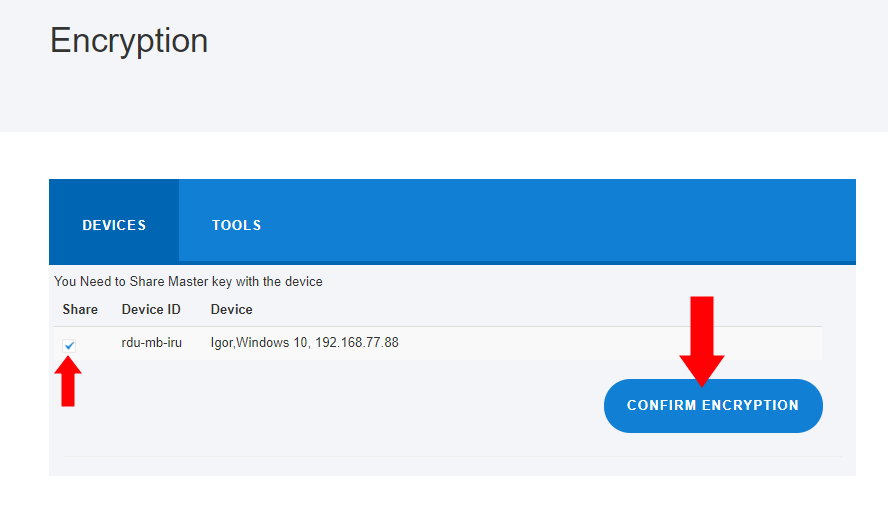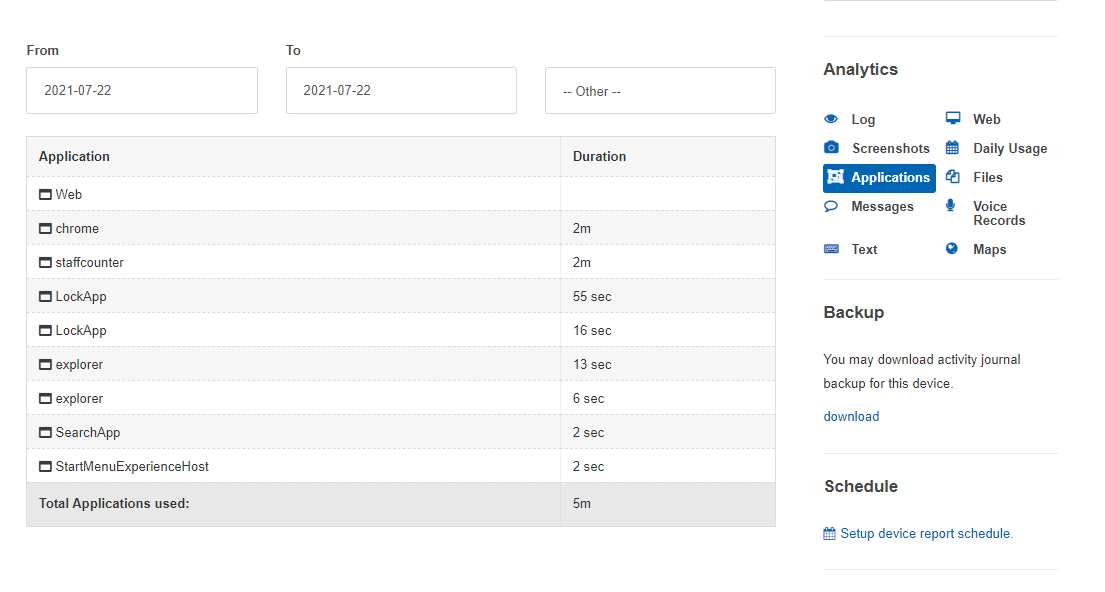Cómo habilitar el cifrado de extremo a extremo (E2EE)
Hoy en día, KidLogger es la primera solución en el mundo que ofrece cifrado de extremo a extremo (E2EE). Todos los datos recopilados desde los ordenadores del niño serán cifrados y descifrados únicamente para el propietario de la cuenta. Los datos de actividad del niño recopilados desde dispositivos finales serán cifrados antes de ser enviados a nuestro servicio en la nube. La principal diferencia con el cifrado SSL es que los datos permanecen cifrados cuando llegan al almacenamiento en la nube de KidLogger, y además, permanecen cifrados incluso en todos los tipos de instancias de bases de datos en ejecución, contextos de ejecución y algoritmos de procesamiento en nuestros servidores en la nube. Cuando inicias sesión en tu cuenta, los datos se entregan al navegador web en su forma cifrada inicial y se descifran sobre la marcha directamente en la página del navegador utilizando el programa Java-Script y las funciones de cifrado del navegador. Aquí explicamos cómo actualizar o instalar el nuevo agente KidLogger y configurar la función de cifrado E2EE.
Nos gustaría anunciar que la función "Cifrado de Extremo a Extremo" ya está publicada y disponible en modo experimental para nuevas cuentas de usuario. Al igual que cualquier otra solución de seguimiento del tiempo, KidLogger registra la frecuencia y duración de cada aplicación, documento y página web abierta por el niño, calcula el tiempo dedicado a cada elemento y luego ordena los resultados para los informes. Pero ahora, la arquitectura de E2EE en KidLogger permite proteger datos sensibles incluso del propio servidor de KidLogger, ya que el contenido siempre está cifrado.
Para probar la función E2EE, debes descargar el nuevo agente KidLogger para Windows con soporte para "Cifrado de Extremo a Extremo" y seguir los pasos descritos a continuación.
Activa la configuración de cifrado
Visita la sección perfil y haz clic en "Activar cifrado". Ten en cuenta que esta opción no afectará a los dispositivos y datos existentes para tu cuenta.

Haz clic en Respaldar claves para descargar el archivo de respaldo de tu Clave Maestra de Cifrado. Esto te permitirá acceder a tus datos en modo fuera de línea y también restaurar el acceso a tu cuenta si olvidas la contraseña.
Instala el nuevo Agente KidLogger
Descargar el nuevo Agente KidLogger
Para actualización: simplemente reinstala KidLogger sobre la versión existente. Para una nueva instalación: instálalo y abre KidLogger para conectarlo a tu cuenta. Más información sobre cómo conectarlo.
Una vez agregado el dispositivo, comenzará a cargar solo datos anónimos sobre la actividad del niño en texto claro, hasta que confirmes el cifrado para él en el perfil de tu cuenta, como se describe en la siguiente sección.
Confirma nuevos dispositivos con datos cifrados
Después de actualizar o instalar con éxito la nueva aplicación Agente KidLogger, debes visitar nuevamente el tablero. Deberías ver una notificación para confirmar nuevos dispositivos con soporte para cifrado. Sigue el enlace de confirmación>
En la página de Perfil, en la sección de Cifrado, marca el nuevo dispositivo y haz clic en Confirmar Cifrado.

Listo. En el transcurso de una hora, la confirmación será recibida por la aplicación Agente KidLogger en la computadora y comenzará a recopilar y cifrar todos los datos de actividad de acuerdo con la configuración.
Navega por el tablero y los informes cifrados
No notarás muchos cambios en tu tablero y en tus informes, aunque toda la información esté cifrada. Esto es posible gracias al proceso de descifrado en tiempo real directamente en el navegador web, gracias al estándar de API Web Crypto que está disponible en la mayoría de los navegadores como Chrome, Firefox, Opera, Safari y otros. El código JavaScript desarrollado especialmente funciona en el navegador y descifra continuamente todas las cadenas cifradas en el contenido de la página web devuelta por el servicio KidLogger.
Cómo E2EE afecta el seguimiento del tiempo?
De hecho, los datos opacos cifrados tienen una estructura idéntica a la de los datos en texto claro. Por ejemplo, antes del cifrado, KidLogger utiliza la cadena "winword.exe" o "gmail.com" para calcular el tiempo total pasado en la aplicación.
Después de habilitar el cifrado, KidLogger utiliza cadenas tokenizadas que parecen "w6Wd4SSxgK9EqmHuR4EAWw==" o "UssM8UxGazi4kDxn5JDO4g==" para calcular el mismo tiempo total. Esto es posible porque se utiliza una única clave de cifrado para cifrar todos los datos transferidos por los ordenadores de una determinada cuenta a la servidor de KidLogger. Por lo tanto, el nombre específico de la aplicación, el título o la URL mantienen la misma forma de texto tokenizado en los datos de una única cuenta. Esto permite procesar datos cifrados de la misma manera, pero con el más alto nivel de anonimidad y privacidad.

Informes de correo electrónico cifrados
Todos los informes generados a la dirección de correo electrónico de la cuenta contendrán datos cifrados. Estamos trabajando para publicar un complemento para navegador que permitirá descifrar los informes de KidLogger en cualquier correo electrónico basado en la web, como Gmail o Outlook.
Copia de seguridad cifrada
KidLogger permite descargar todos los datos de un ordenador o departamento específico. Estos datos incluyen un registro en bruto de las acciones del usuario en orden cronológico y capturas de pantalla. Con el cifrado habilitado, esta copia de seguridad estará cifrada. Para ver los datos, debes instalar el complemento SafeJKA para el navegador.
Notas técnicas
La funcionalidad de E2EE es de código abierto y está disponible en el archivo jsec.js, que se puede encontrar en línea en kidlogger.net. El cifrado se basa en el API de Web Crypto que está disponible en la mayoría de los navegadores y se ejecuta únicamente en la memoria del navegador. El servicio KidLogger ayuda a almacenar e intercambiar claves públicas y datos cifrados opacos entre el propietario de la cuenta de usuario y el ordenador que tiene instalada la aplicación Agente KidLogger.
Especificación de Cifrado de Extremo a Extremo de KidLogger en resumen:
Cada cuenta de usuario y los agentes de KidLogger instalados en los ordenadores generan su propio par de claves RSA con claves privadas y públicas de 2048 bits. El propietario de la cuenta genera una clave de cifrado AES de 256 bits aleatoria, llamada Clave Maestra. La Clave Maestra está protegida por la contraseña de la cuenta de usuario mediante una clave intermedia PBKDF/AES-256 y se almacena en el servicio KidLogger como un blob cifrado. La cuenta de usuario cifra la Clave Maestra con RSA-SHA1 y la envía a los ordenadores a través del servicio KidLogger en forma de blob cifrado. El agente KidLogger cifra la información sensible en los datos de productividad con la Clave Maestra AES de 256 bits: nombre de la aplicación, título de la ventana, dirección URL, pulsaciones de teclas, portapapeles, texto de chat, nombre del documento, capturas de pantalla, fotos de la cámara, datos de audio. Los metadatos como tipo de acción, hora y duración se almacenan en texto claro.
La derivación de claves PBKDF se utiliza para proteger la contraseña de la cuenta de usuario y generar claves de cifrado intermedias.
La contraseña de la cuenta de usuario nunca se envía al servidor de KidLogger en texto claro. Una vez habilitado, el cifrado de datos no se puede desactivar en la cuenta de KidLogger y en las aplicaciones de Agente. El servicio KidLogger no realiza operaciones criptográficas y solo almacena claves públicas o datos cifrados opacos. Estamos trabajando en mejoras adicionales para permitir a los propietarios de cuentas almacenar la Clave Maestra y las claves secretas RSA correspondientes únicamente en la memoria del navegador en una computadora de confianza. Actualmente, estamos trabajando en el complemento SafeJKA para navegadores que implementará una autenticación robusta y el principio de posesión del cifrado.
Aquí puedes encontrar tutoriales, artículos y anuncios sobre KidLogger SAS: qué nuevas funciones hemos implementado, cómo instalar KidLogger y cómo configurar la supervisión de usuarios para diferentes plataformas como Windows, Mac, Android.
Nos encantaría escuchar cualquier sugerencia que tengas para mejorar KidLogger.
"Nunca dejes a los niños y empleados sin supervisión."
Archive
Últimas noticias
- 08 ene.
- 30 dic.
- 10 dic.
- 22 nov.
- 17 nov.
- 21 oct.
- 17 oct.
- 11 oct.
- 30 sept.
- 24 sept.
